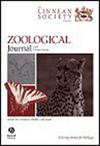Flightless beetles crossed the Pacific Ocean: phylogeny and biogeography of the intertidal genus Diaulota Casey (Coleoptera: Staphylinidae: Aleocharinae)
IF 3
2区 生物学
Q1 ZOOLOGY
引用次数: 0
Abstract
The North Pacific distribution of coastal staphylinids may be explained as the result of either dispersal or vicariance. The intertidal rove beetle genus Diaulota is a submarine group that occurs on the Pacific coasts of the Northern Hemisphere. We performed a phylogenetic analysis of Diaulota using molecular characters (3241 bp) to investigate their biogeographic history and patterns. The data were analysed by parsimony, Bayesian, and maximum likelihood methods. Model-based analyses showed the same pattern of Diaulota species relationships, but parsimony analysis resulted in different species relationships for the unresolved clade B. Biogeographical analyses suggested that the common ancestor of Diaulota occurred widely along the East Asian coast with repeated dispersal to the north-eastern Pacific from the north-western Pacific. According to the reconstruction of the ancestral areas, both dispersal (seven events) and vicariance (four events) were important in shaping its current distribution. Although most species underwent stepwise colonization from East Asia via Kamchatka and Alaska to North America along the coast, a single lineage (Diaulota fulviventris and Diaulota harteri) crossed the Pacific Ocean directly from the north-western Pacific to the north-eastern Pacific, possibly via sea surface currents.横跨太平洋的不会飞的甲虫:潮间带属 Diaulota Casey 的系统发育和生物地理学(鞘翅目:蝶形目:Aleocharinae)
北太平洋沿岸金龟子的分布可以解释为传播或沧海桑田的结果。潮间带喙甲虫属(Diaulota)是出现在北半球太平洋沿岸的一个海底类群。我们利用分子特征(3241 bp)对Diaulota进行了系统进化分析,以研究其生物地理历史和模式。我们采用解析法、贝叶斯法和最大似然法对数据进行了分析。生物地理学分析表明,Diaulota 的共同祖先广泛分布于东亚沿海,并从西北太平洋向东北太平洋反复扩散。根据对祖先地区的重建,扩散(7 次)和迁徙(4 次)都是形成其目前分布的重要因素。虽然大多数物种是从东亚经堪察加半岛和阿拉斯加沿海岸线逐步移居到北美的,但有一个种系(Diaulota fulviventris 和 Diaulota harteri)可能通过海面洋流从西北太平洋直接跨越太平洋到达东北太平洋。
本文章由计算机程序翻译,如有差异,请以英文原文为准。
求助全文
约1分钟内获得全文
求助全文
来源期刊
CiteScore
6.50
自引率
10.70%
发文量
116
审稿时长
6-12 weeks
期刊介绍:
The Zoological Journal of the Linnean Society publishes papers on systematic and evolutionary zoology and comparative, functional and other studies where relevant to these areas. Studies of extinct as well as living animals are included. Reviews are also published; these may be invited by the Editorial Board, but uninvited reviews may also be considered. The Zoological Journal also has a wide circulation amongst zoologists and although narrowly specialized papers are not excluded, potential authors should bear that readership in mind.

 求助内容:
求助内容: 应助结果提醒方式:
应助结果提醒方式:


